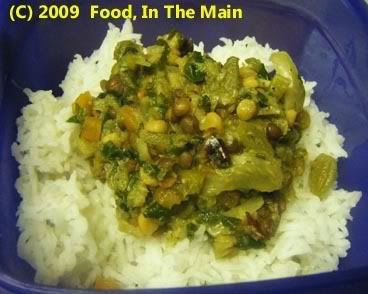skip to main |
skip to sidebar
This gorgeous emerald coloured chutney is many kinds of pretty - pretty beautiful, pretty tasty, pretty versatile, pretty healthy, pretty easy to make...
So go and make it. Pretty please.
Recipe for: Spinach-onion-cabbage chutney

Ingredients:
1 cup spinach leaves
1/2 cup cabbage, sliced
1 medium onion, sliced
A good handful of chives
2 cloves garlic, sliced
1 tbsp oil
2 tsp urad dal
1 tsp tamarind paste or a gooseberry sized piece of tamarind
5-6 dried red chillies (or to taste)
1/4 tsp asafoetida powder (optional)
2 tsp mustard seeds
4-5 fresh or frozen curry leaves
Salt to taste
Method:
1. Heat the oil and when it shimmers, add the mustard seeds and cover the pan till they finish popping.
2. Now add the urad dal, red chillies, curry leaves and asafoetida powder. Stir-fry till the urad dal turns a pale golden brown and the red chillies are a shiny darker shade.
3. Add the garlic, chives and onion and stir-fry till the onions start to soften and turn translucent.
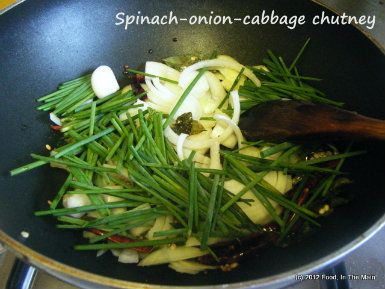
4. Add the cabbage and fry it till it wilts,
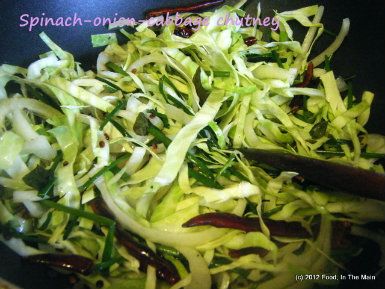
then the spinach until it wilts too.

Let this mixture cool.
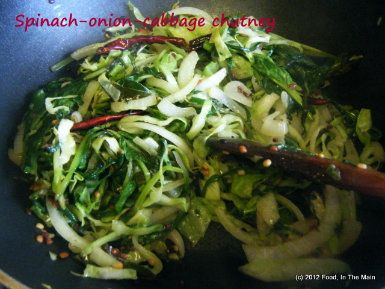
5. Pick out the red chillies and grind them to a smooth paste with the tamarind and a couple of spoonfuls of the vegetable mixture.
6. Now add the rest of the cabbage-onion-spinach mix
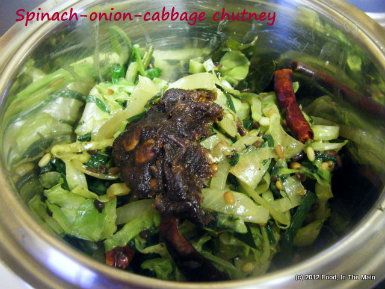
and grind it to a fairly smooth consistency - but not to a puree. It should be a little bit coarse.
7. Remove the chutney to a bowl, add salt to taste and mix well. This can be mixed with rice or eaten as a side dish/dip with chapaties, dosas, idlis etc.
RECIPE: SPINACH-ONION-CABBAGE CHUTNEY
Ingredients:
1 cup spinach leaves
1/2 cup cabbage, sliced
1 medium onion, sliced
A good handful of chives
2 cloves garlic, sliced
1 tbsp oil
2 tsp urad dal
1 tsp tamarind paste or a gooseberry sized piece of tamarind
5-6 dried red chillies (or to taste)
1/4 tsp asafoetida powder (optional)
2 tsp mustard seeds
4-5 fresh or frozen curry leaves
Salt to taste
Method:
1. Heat the oil and when it shimmers, add the mustard seeds and cover the pan till they finish popping.
2. Now add the urad dal, red chillies, curry leaves and asafoetida powder. Stir-fry till the urad dal turns a pale golden brown and the red chillies are a shiny darker shade.
3. Add the garlic, chive and onion and stir-fry till the onions start to soften and turn translucent.
4. Add the cabbage and fry it till it wilts, then the spinach until it wilts too. Let this mixture cool.
5. Pick out the red chillies and grind them to a smooth paste with the tamarind and a couple of spoonfuls of the vegetable mixture..
6. Now add the rest of the cabbage-onion-spinach mix and grind it to a fairly smooth consistency - but not to a puree. It should be a little bit coarse.
7. Remove the chutney to a bowl, add salt to taste and mix well. This can be mixed with rice or eaten as a side dish/dip with chapaties, dosas, idlis etc.
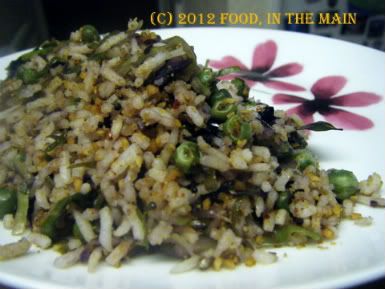 Cabbage is one of my favourite vegetables, pretty much no matter how it’s cooked – as long as that doesn’t mean cooking it to a stinky sulphur-y mush. I don’t care much for white cabbage, because (in my opinion) it’s stinkier and sulphur-ier than green cabbage. (It might not be any more or less smelly, you understand - I’m just quoting the opinion put forward by my nose). Purple cabbage is kinda like white cabbage except purple… and because it’s a pretty colour for cabbage, I don’t shun it.
But the cabbage I use the most is a pointy, tear-drop shaped green cabbage marketed under the name “sweetheart cabbage” in the supermarkets here. That said, I quite like the round green kind too. But sweetheart by name, sweetheart by taste – no, ok, that simile doesn’t work. There’s a good reason I’m not a world-famous writer, I suppose.
Anyway, those are the three types of cabbage available - unless you count the round green cabbage as a different variety from the pointy green one… in which case, the cabbage count goes from three to four. I’m sure that, like potatoes, there are hundreds of different varieties of cabbage, all of which have individual names, again like potatoes. I probably just don’t know about them.
Cabbage is one of my favourite vegetables, pretty much no matter how it’s cooked – as long as that doesn’t mean cooking it to a stinky sulphur-y mush. I don’t care much for white cabbage, because (in my opinion) it’s stinkier and sulphur-ier than green cabbage. (It might not be any more or less smelly, you understand - I’m just quoting the opinion put forward by my nose). Purple cabbage is kinda like white cabbage except purple… and because it’s a pretty colour for cabbage, I don’t shun it.
But the cabbage I use the most is a pointy, tear-drop shaped green cabbage marketed under the name “sweetheart cabbage” in the supermarkets here. That said, I quite like the round green kind too. But sweetheart by name, sweetheart by taste – no, ok, that simile doesn’t work. There’s a good reason I’m not a world-famous writer, I suppose.
Anyway, those are the three types of cabbage available - unless you count the round green cabbage as a different variety from the pointy green one… in which case, the cabbage count goes from three to four. I’m sure that, like potatoes, there are hundreds of different varieties of cabbage, all of which have individual names, again like potatoes. I probably just don’t know about them.
So, coming back to what I do know (a much shorter topic, haha), which is that I love cabbage, what I made with a combination of green and purple cabbage was a luvverly rice dish. With added peas. There's hardly anything that doesn't benefit from the addition of peas, unless it's a cake. Although I bet someone somewhere has tried a green peas cake and written about it on their blog... Ok, I'm off to google for green peas cake now, but you please feel free to read my recipe below and try it out, because it's really, really tasty - especially if you're a cabbage enthusiast like me.
Recipe for: Cabbage and peas rice
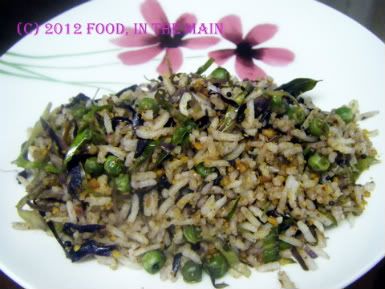 Ingredients:
Ingredients:
2 cups cooked basmati rice
3 cups cabbage, finely shredded
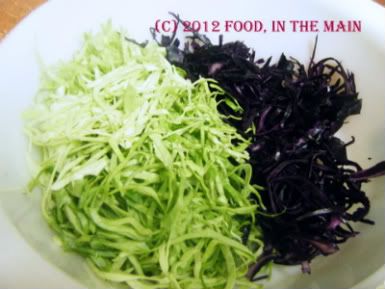 1/2 cup peas (fresh or frozen)
1 tsp oil
2 tsp mustard seeds
1/4 tsp asafoetida powder
a few fresh/frozen curry leaves
Salt to taste
Peanuts and chopped coriander leaves for garnish (optional)
1/2 cup peas (fresh or frozen)
1 tsp oil
2 tsp mustard seeds
1/4 tsp asafoetida powder
a few fresh/frozen curry leaves
Salt to taste
Peanuts and chopped coriander leaves for garnish (optional)
For the masala powder:
1/2 tsp oil
1 htsp urad dal
1 htsp tuvar dal
1 htsp chana dal
1 htsp coriander seeds
4-5 dried red chillies (or to taste)
2 tbsp shredded fresh or dry coconut
Method:
1. Heat 1/2 tsp oil in a large pan.  Fry the masala powder ingredients (bar the coconut) over a low flame till the dals turn a pale golden brown, and the chillies are a shiny dark red. Remove to a plate and let cool.
2. Grind the cooled roasted dals along with the coconut to a fairly smooth powder.
Fry the masala powder ingredients (bar the coconut) over a low flame till the dals turn a pale golden brown, and the chillies are a shiny dark red. Remove to a plate and let cool.
2. Grind the cooled roasted dals along with the coconut to a fairly smooth powder.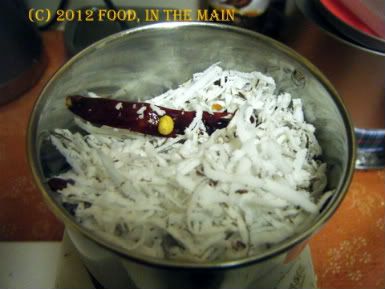 Reserve.
Reserve.
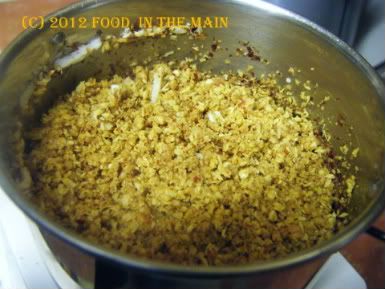 3. Heat the remaining oil in the same pan and add the asafoetida powder, curry leaves and mustard seeds. Cover the pan and let the seeds pop.
3. Heat the remaining oil in the same pan and add the asafoetida powder, curry leaves and mustard seeds. Cover the pan and let the seeds pop.
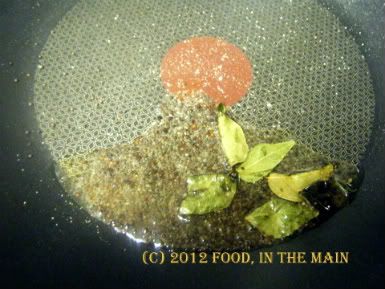 4. Now add the shredded cabbage and peas and stir well.
4. Now add the shredded cabbage and peas and stir well. 
Cover the pan tightly and let the vegetables cook on a very low heat for about 7 minutes, till the cabbage is cooked but still retains some bite.
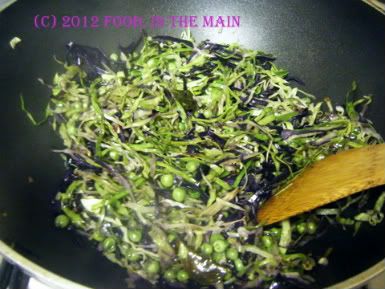 5. Once the cabbage is done, add the ground coconut masala powder and salt to taste, and mix well.
5. Once the cabbage is done, add the ground coconut masala powder and salt to taste, and mix well.
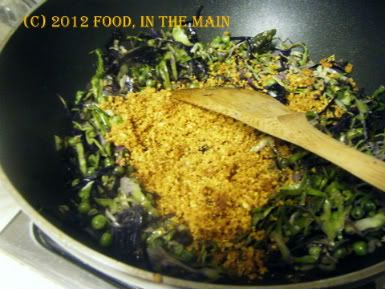
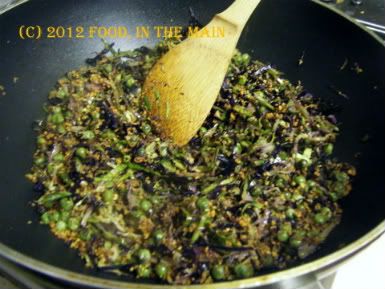 6. Then add the rice and mix it in carefully until it is distributed evenly.
6. Then add the rice and mix it in carefully until it is distributed evenly. 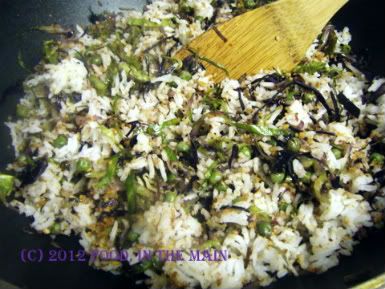
Add the chopped coriander (if using) and scatter the roasted peanuts over. Serve hot with cucumber raita and papad or crisps on the side.
RECIPE: CABBAGE AND PEAS RICE
Ingredients:
2 cups cooked basmati rice
3 cups cabbage, finely shredded
1/2 cup peas (fresh or frozen)
1 tsp oil
2 tsp mustard seeds
1/4 tsp asafoetida powder
a few fresh/frozen curry
Salt to taste
Peanuts and chopped coriander leaves for garnish (optional)
For the masala powder:
1/2 tsp oil
1 htsp urad dal
1 htsp tuvar dal
1 htsp chana dal
1 htsp coriander seeds
4-5 dried red chillies (or to taste)
2 tbsp shredded fresh or dry coconut
Method:
1. Heat 1/2 tsp oil in a large pan and fry the masala powder ingredients (bar the coconut) over a low flame till the dals turn a pale golden brown, and the chillies are a shiny dark red. Remove to a plate and let cool.
2. Grind the cooled roasted dals along with the coconut to a fairly smooth powder. Reserve.
3. Heat the remaining oil in the same pan and add the asafoetida powder, curry leaves and mustard seeds. Cover the pan and let the seeds pop.
4. Now add the shredded cabbage and peas and stir well. Cover the pan tightly and let the vegetables cook on a very low heat for about 7 minutes, till the cabbage is cooked but still retains some bite.
5. Once the cabbage is done, add the ground coconut masala powder and salt to taste, and mix well.
6. Then add the rice and mix it in carefully until it is distributed evenly. Add the chopped coriander (if using) and scatter the roasted peanuts over. Serve hot with cucumber raita.
There's something I wanted to say before I began this post... I wonder what it was.... hmmm. Oh yeah. This recipe marks my 401th post. I can't help wondering how long it's going to take me to reach the 500 mark. When I see bloggers (like Raji at Talimpu) post one new recipe literally every day of the week (weekends not included), week after week, I cannot but feel genuine amazement and respect. I can bet that most of these bloggers have far, far busier lives than I do, with kids to look after and all... and yet I'm the one who is the least prolific. My problem is that I'd rather read than do anything else when I have the time - so I keep falling back on familiar recipes that don't take any extra time or effort. I've really got to change that procrastinatory attitude as well... I think I'll wait till the New Year for that, though. Yeah I know, pathetic. Joke and attitude both. However, I yam what I tuber, as Popeye would say... not. So, today's recipe is simple. Simple simple simple. In other words, simple. And, if you can reduce the oil-content to nil, it can quite literally be guilt-free (rather than almost guilt-free as it is now). The recipe is for cabbage thogayal/chutney, without using even a teaspoon of the dreaded coconut. It tastes so MUCH like the authentic version that it's unbelievable. Remember, I'm saying this as a person who's unable to fool her taste buds all of the time - I simply cannot bring myself to say that something is tasty when it is not... and sod how healthy it's meant to be. So if I say that this thogayal loses nothing but the cholesterol from the coconut while tasting exactly the same - believe me, it's true. My sister can vouch for it, too - both what I've just said and the thogayal. The first time I made it, I couldn't believe how yummy it was. I had to keep reminding myself that even if I ate ALL the thogayal at one sitting, it would still mean that I'd only eaten all the cabbage. It was an amazing realisation! Kind of like the way I felt when I started driving by myself after getting my licence - I had to keep reminding myself not to flinch if I saw a police car as I was a legitimate driver with a full driving licence! It took a while to stop feeling like a fraud. This thogayal, then, is the eating equivalent of your full driving licence, where you will need to feel neither guilty nor a fraud for eating all of it. The BEST part, however, is that you won't need a learner licence or pass any exams to get this licence. Is that a deal or is that a deal?Recipe for: Almost guilt-free cabbage thogayal

Ingredients:
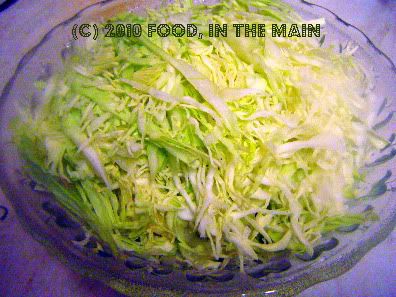
4 cups thinly sliced green cabbage
3-4 dried red chillies (or to taste)
2 tsp oil
1 tbsp urad dal
10 fresh curry leaves
1/2 tsp tamarind paste (or large marble-sized piece of dried tamarind)
1/4 tsp asafoetida powder
Salt to taste
Method:
1. Heat the oil in a frying pan and add the curry leaves, red chillies, urad dal and asafoetida powder.
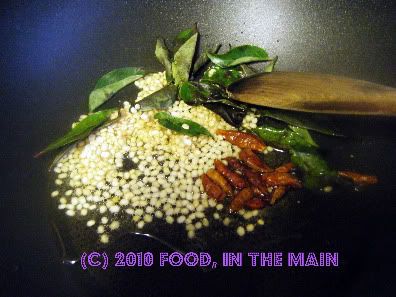
2. Fry these till the dals are golden brown and the red chillies a darker shade. Remove all the red chillies and most of the dal and curry leaves. Reserve for later.
3. Add the sliced green cabbage to the pan (adding a tsp oil more if you feel like it), stir well and let it cook on medium heat till the cabbage is soft and wilted.
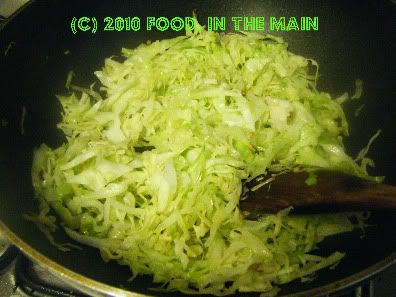
4. Let the cabbage cool.
5. Put all the chillies, the tamarind, and all but 1/2 tsp of the dal/curry leaves in a mixie along with some of the cabbage, and grind it to a smooth paste.
6. Now add the rest of the cabbage and grind to a more coarse paste. Add the remaining 1/2 tsp dal/curry leaves and give it all one quick final whirl so that the dal remains mostly whole to provide a bit of crunch.
7. Remove to a serving bowl and add salt to taste. Mix well and serve immediately with hot plain rice and ghee and any vegetable dish. This thogayal is also good as a side dish for dosas, idlis, etc and makes a great base for sandwiches.
Note: The thogayal's shelf life is not particularly good if left outside, especially in hot weather; any leftovers should be stored in the fridge in a tightly-closed container and used within 2 days.
RECIPE FOR: ALMOST GUILT-FREE CABBAGE THOGAYAL
Ingredients:
4 cups thinly sliced green cabbage
3-4 dried red chillies (or to taste)
2 tsp oil
1 tbsp urad dal
10 fresh curry leaves
1/2 tsp tamarind paste (or large marble-sized piece of dried tamarind)
1/4 tsp asafoetida powder
Salt to taste
Method:
1. Heat the oil in a frying pan and add the curry leaves, red chillies, urad dal and asafoetida powder.
2. Fry these till the dals are golden brown and the red chillies a darker shade. Remove all the red chillies and most of the dal and curry leaves. Reserve for later.
3. Add the sliced green cabbage to the pan (adding a tsp oil more if you feel like it), stir well and let it cook on medium heat till the cabbage is soft and wilted.
4. Let the cabbage cool.
5. Put all the chillies, the tamarind, and all but 1/2 tsp of the dal/curry leaves in a mixie along with some of the cabbage, and grind it to a smooth paste.
6. Now add the rest of the cabbage and grind to a more coarse paste. Add the remaining 1/2 tsp dal/curry leaves and give it all one quick final whirl so that the dal remains mostly whole to provide a bit of crunch.
7. Remove to a serving bowl and add salt to taste. Mix well and serve immediately with hot plain rice and ghee and any vegetable dish. This thogayal is also good as a side dish for dosas, idlis, etc and makes a great base for sandwiches.
Note: The thogayal's shelf life is not particularly good if left outside, especially in hot weather; any leftovers should be stored in the fridge in a tightly-closed container and used within 2 days.
I’ve always liked kootu with lots of dal in it, even when some of the kootus have plenty of cooked and mashed dal in them to start with. If any time my mother made vazhakkai kootu, for instance, which has cooked mashed tur dal to thicken it, I would still want lots of cooked-but-firm chana dal in it, as well as plenty of crunchy fried urad dal in the tempering. Nothing less would do.
I like lots of urad dal tempering in dry vegetable dishes too, and always have. And because I do my own cooking, I’m at perfect liberty to use vast quantities of any dal I like without anybody questioning the authenticity of what are meant to be traditional recipes.
Still, I’m not so wrapped up in my own quirks that I don’t realise that other people might not share my preferences, so I usually tone down the quantities of dals in the recipes I publish on this blog, in the hope that I (and my recipes) will come across as normal to readers. (I’m not entirely sure that the ploy works, though. Does it?)
This kootu is pretty simple, and you can use pretty much whatever vegetables you have at hand (but I wouldn’t recommend okra, fresh or frozen). I use a pressure-cooker to cook the vegetables and dal together, but if you don't have one, or don't like to use it, the dals can be cooked separately, the vegetables steamed or boiled separately, and then brought together from Step 7. I'd recommend the pressure-cooker, though - it makes things much simpler. I personally feel that the dals make it not only nutritious but also very tasty. Have the kootu over rice, with a couple of microwaved appalam/poppadums and any pickle (I recommend mango thokku) and a cup of yogurt on the side, and you will discover one of the many ways to gain entry into my personal foodie heaven.
Recipe for: Two-dal vegetable kootu
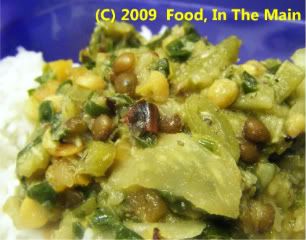
Ingredients:
2.5 cups vegetables cut up small (I used cabbage, carrots, runner beans, potatoes and spinach)
1/4 cup chana dal
1/4 cup whole masoor dal
1/2 tsp turmeric powder
2 dried red chillies, chopped up fine1 tsp oil2 tbsp urad dal2 tsp brown mustard seeds1 tsp cumin seeds1/4 tsp asafoetida powder (optional)Salt to tasteAbout 2.5 cups water, or as required
Grind to a smooth paste:
3 tbsp grated fresh or frozen coconut (thawed)
4-5 green chillies (or to taste)
1/2 tsp cumin seeds
1 tbsp rice flour
Method:
1. If using cabbage, shred finely. Chop up any other vegetables you're using into small even-sized pieces.

2. Wash the two dals in cold water.
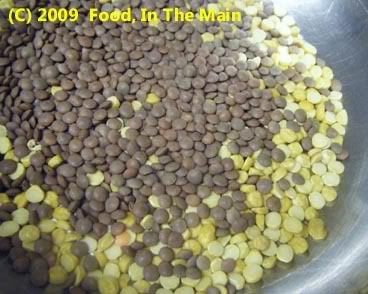
3. In an appropriately sized vessel that can go in your pressure cooker, place the dals at the bottom, then add the "hard" vegetables (like potatoes, carrots, etc), and finally the easy-cook vegetables like cabbage and frozen peas. If using spinach, DO NOT add to the vessel at this point.
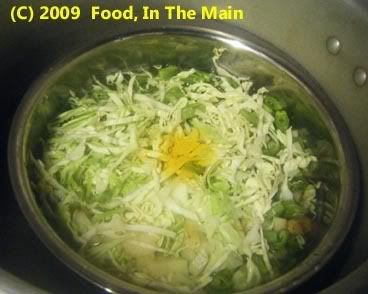
Top with the turmeric powder and add enough water to just about cover the vegetables.
4. Pressure-cook for three whistles, and let the pressure drop naturally before opening the cooker.
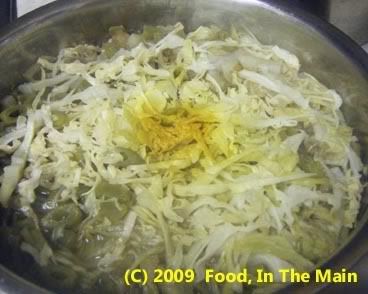
5. In a pan, heat the oil. Add the mustard seeds, chopped dried red chillies, cumin seeds, urad dal and asafoetida powder. Cover and let the mustard seeds pop (about 30 seconds). The urad dal should have turned a golden brown.

6. Add the spinach leaves now (if using)

and stir fry till it is wilted but still green.
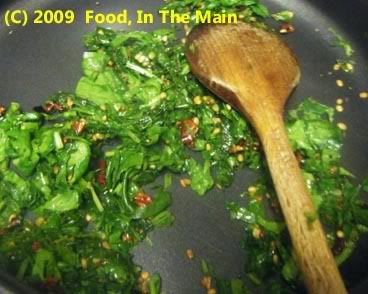
7. Lower the heat and add the cooked dal + vegetables to the pan (the liquid will sputter, so be careful).
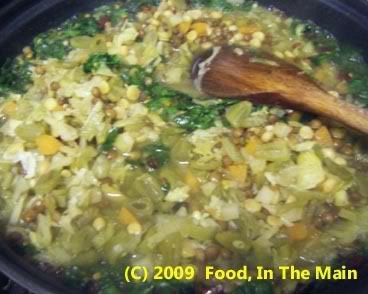
8. Pour in the ground coconut masala.
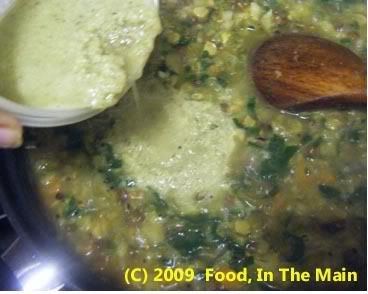
Add salt to taste and mix well. Add more water if required (the kootu can be thick or a bit runny, depending on your taste. I keep it thick if it's a side dish for rotis or chapatis, and a bit runnier if it's to be served over rice.)
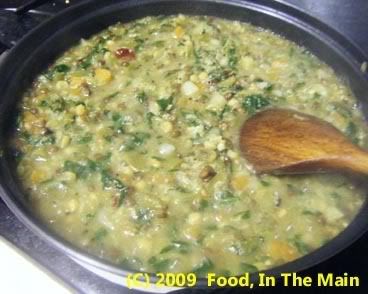
9. Serve hot over plain steamed white rice, or with chapaties.
